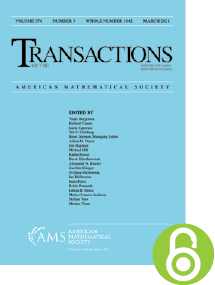Extending the Hölder type inequality of Blakley and Roy to non-symmetric non-square matrices
HTML articles powered by AMS MathViewer
- by Thomas H. Pate PDF
- Trans. Amer. Math. Soc. 364 (2012), 4267-4281 Request permission
Abstract:
Suppose $m$, $n$, and $k$ are positive integers, and let $\langle \cdot ,\cdot \rangle$ denote standard inner product on the spaces $\mathbb R^p$, $p\!>\!0$. We show that if $D$ is an $m\!\times \!n$ non-negative real matrix, and $u$ and $v$ are non-negative unit vectors in $\mathbb R^n$ and $\mathbb R^m$, respectively, then \begin{equation} \langle (D\!D^t)^k D u ,v \rangle \ge \langle Du,v \rangle ^{2k+1}, \end{equation} with equality if and only if $\langle (DD^t)^k D u ,v \rangle = 0$, or there exists $\alpha > 0$ such that $Du = \alpha v$ and $D^t v = \alpha u$. This inequality extends to non-symmetric non-square matrices a 1965 result of Blakley and Roy which asserts that if $D$ is a non-negative $n\!\times \!n$ symmetric matrix, and $u\!\in \!\mathbb R^n$ is a non-negative unit vector, then \begin{equation} \langle D^k u, u \rangle \ge \langle Du,u \rangle ^{k}, \end{equation} with equality, when $k\!\ge \!2$, if and only if $\langle D^k u, u \big \rangle = 0$, or there exists $\alpha \!>\!0$ such that $Du = \alpha u$. The generality of the inequality (1) derives not only from the fact that $D$ is not assumed to be symmetric or square, but from the fact that we admit two unit vectors $u$ and $v$ instead of the single unit vector $u$ appearing in inequality (2) of Blakley and Roy. We apply our result to verify the conjecture of A. Sidorenko (1993) in the non-symmetric case provided that the underlying graph is a path.References
- G. R. Blakley and Prabir Roy, A Hölder type inequality for symmetric matrices with nonnegative entries, Proc. Amer. Math. Soc. 16 (1965), 1244–1245. MR 184950, DOI 10.1090/S0002-9939-1965-0184950-9
- G. Hardy, J.E. Littlewood, and G. Pólya, Inequalities, Cambridge University Press, Cambridge, 1999.
- Roger A. Horn and Charles R. Johnson, Matrix analysis, Cambridge University Press, Cambridge, 1985. MR 832183, DOI 10.1017/CBO9780511810817
- Alexander Sidorenko, A correlation inequality for bipartite graphs, Graphs Combin. 9 (1993), no. 2, 201–204. MR 1225933, DOI 10.1007/BF02988307
- A. F. Sidorenko, Inequalities for functionals generated by bipartite graphs, Diskret. Mat. 3 (1991), no. 3, 50–65 (Russian); English transl., Discrete Math. Appl. 2 (1992), no. 5, 489–504. MR 1138091, DOI 10.1515/dma.1992.2.5.489
Additional Information
- Thomas H. Pate
- Affiliation: Department of Mathematics, Auburn University, Auburn, Alabama 36849
- Received by editor(s): August 20, 2010
- Received by editor(s) in revised form: November 5, 2010
- Published electronically: March 20, 2012
- © Copyright 2012 American Mathematical Society
- Journal: Trans. Amer. Math. Soc. 364 (2012), 4267-4281
- MSC (2010): Primary 15A63, 15A42, 15A60, 15A15, 05C50
- DOI: https://doi.org/10.1090/S0002-9947-2012-05501-2
- MathSciNet review: 2912454


